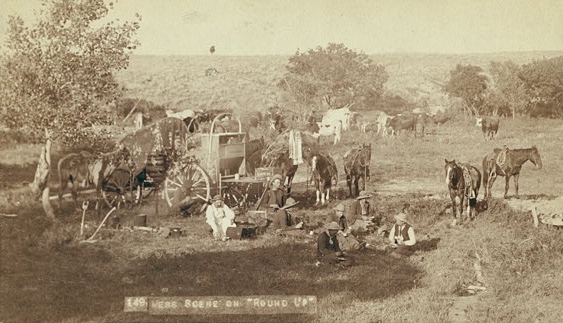
Mess on Roundup, 1890, photo by J. Grabill
Compare with roundup camp photos on preceding pages and with
next photo. Cowboys often could be a rough lot. John Clay noted:
[I]f you wish to be ridden over, stamped upon, get a cowboy to do it, and more
especially the brand we employed in those days in the Sweetwater region.
They were the real simon-pure, devil-may-care, roistering, gambling,
immoral, revolver-heeled, brazen, light-fingered lot, and yet a dash of
bravado among them that was attractive to the stranger. They had no respect
for a man and little for a woman. Yet they were good workers. Many of them
had individually good instincts. "In the herd" they were mean, and to
hesitate with them meant losing. If they bluffed you, good-by to any
discipline.
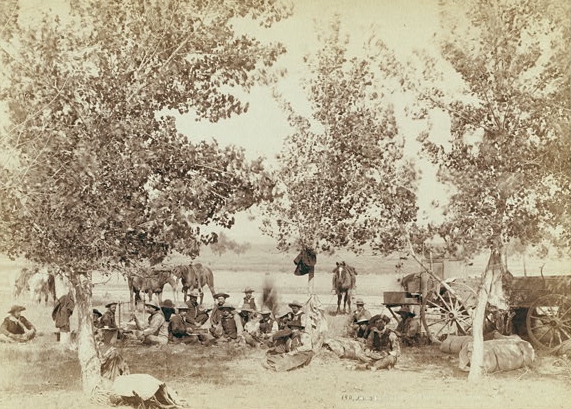
Dinner while on roundup, 1890, photo by J. Grabill.
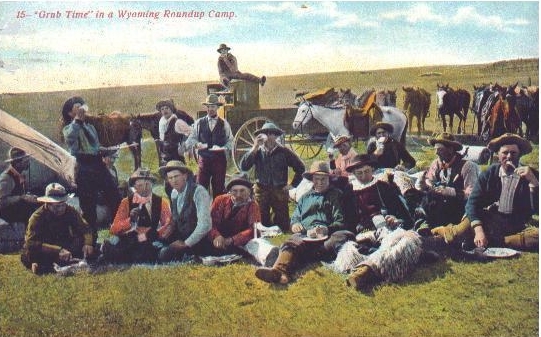
Roundup Camp, Warren Livestock Company, near Cheyenne, 1898, photo by Joseph Stimson. Another view of
same scene below.
The Warren Live Stock Company was incorporated in 1883 and capitalized at $500,000.00 (1883 dollars). It is one of the
few of the former giant corporately owned cattle companies that continues to survive.
Frequently older photographs would be colorized at a later time for postcards.
Such is the above. For information as to J. E. Stimson see
Cheyenne III. The following commentary was written by the roundup foreman in the
photograph, Ashley Gleason, in 1921. Left to right:
"William Fry, photographer, northern New Mexico; L. T. Bennett, busily engaged
in cutting a tough beefsteak, Fort Duckane, Utah; Perry Williams, Cheyenne; Charles Phelps, Casper; Lon Roach,
now state law enforcement official; Roy Baxter, government pack master; Bob Van Horn, son of commanding
officer at Fort Russell; Dick Dummet, A.P.O. rep; was such a poor rep was sent home with his string, and
gladly were the neck tie horses gathered for him; Pete Anderson, didn't want to hide his face with a
cup, but his eagerness to get the sugar settlings, was caught in the act.
Pete was as good a day jingler as any, even though he was a Swede. He was
a physical wreck following the Spanish-American War; Joe Benjamine [sic] wanted to be sure
of getting in, so took to the top of the mess box; Guy McNurlen, a wonderful buster, he has fought many a wild bronk at Frontier
Days; Bill Hosack, Granite Canyon, Wyo., he is wearing among the first angora schaps [sic] introduced
into this country; Ed Clark, Virginia Dale, Wyo; Joe Detrick, has probably
attained greater wealth than any one of the bunch. He left riding because he
couldn't stick with them. He began mining and later accumulated much wealth; Ashley
L. Gleason, in 1921 was foreman for the Fiddleback Co., wool growers Douglas, Wyo;
George Johnson now in California."
[Writer's note: "Sugar settlings" were the sweet grounds from Arbuckle's coffee used on a round-up. Arbuckle's coffee
beans were coated with an egg white and sugar glaze which precluded the beans from going rancid on the
trail. Thus, the coffee was also naturally sweet.]
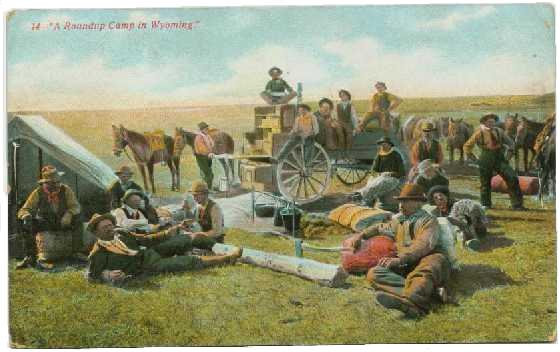
Another view Warren Livestock Company Roundup Camp, 1898, photo by J. E. Stimson
Joe Benjamin is still on top of the mess box. The others
have shifted position somewhat.
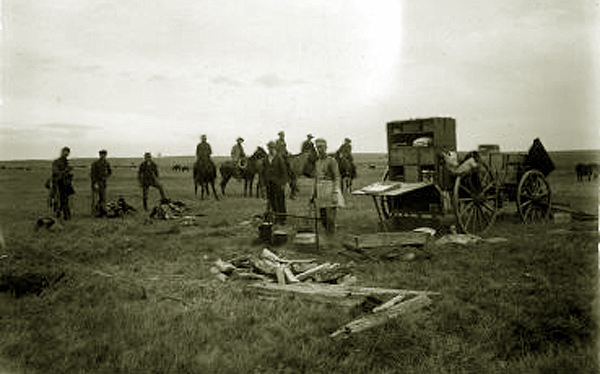
Warren Livestock Company Chuck, 1897
At one time the Warren Livestock Company owned land almost as
far south at Fort Collins. After the turn of the Century it turned increasingly to sheep. Its home ranch was on Pole Creek north of Cheyenne.
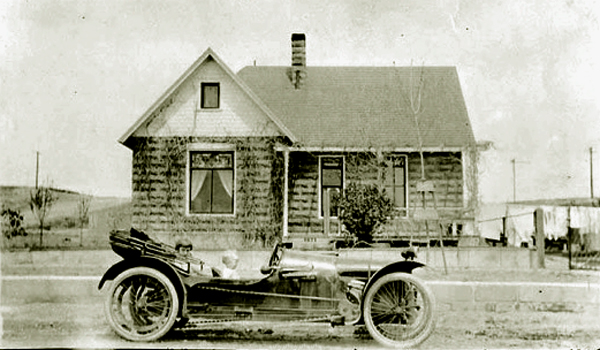
Warren Livestock Company, 1914
Note that the runabout has chain drive. Prior to World War I a number of smaller automobile companies used at one time
or another chain drive as opposed to shaft drive. Companies using chain drive included
Mercedes, American Locomotive Automobile Co. (Alco), Matheson, Simplex, Fiat, and Thomas. According to K. W. Najer, "Automobile Rear Axle Design,
Machinery Magazine, Sept. 1913, p. 36, the advantage of chain drive as opposed to
shaft drive was:
[W]hen chain drive is applied, the rear axle is made from one piece, and is not parted in the center as is the case with a shaft driven
axle. Further, in regard to the bending stresses, the axle can obtain the most favorable
I-section. It does not carry any heavy parts, like differential gears and their housing,
and being light and free from other weights, it can travel a rough road much more easily,
is not subjected to very severe shocks, the bumps of the axle are reduced and in consequence
the life of the tires and the rims is much longer.
Considering the condition of roads in Wyoming at the time, that might be an advantage.
Mr. Najer continued, however the chain drive was exposed to dust and dirt and therefore it suffered in longevity. Better steel eliminated the
disadvantage of shaft drive. If anyone can identify the car
make, year, and model please email the writer.
Although as indicated on the preceding page, life on the trail or on roundup may have been hard, dangerous, dirty,
and boring, occasionally cowboys would, as illustrated by the bottom
two photos, amuse themselves by rounding up other types of
animals. Acting Governor Amos W. Barber recounted a favorite antic of cowboys dealing with
rattlesnakes:
A still more dangerous practice, and one which I have frequently seen, is a
method of playing with the rattlesnake for the delectation of the cow boy
at the expense of a "tenderfoot." It is well known that unless a snake is
coiled, or held by the tail or body, or placed at length in a hole or
crevice so narrow that by rendering its length sinuous a certain amount of
support is given, it cannot strike. On this theory a mounted cow boy first
puts a rattler to flight, then pushes his pony in pursuit, stoops from the
saddle, seizes it by the tail, gives a quick upward jerk, and, swinging it
so rapidly around his head that it is impossible for it to strike, sets off
in pursuit of whoever has exhibited most terror at the sight of the reptile.
When within fair distance he hurls the snake at the unfortunate victim, in
the full assurance that even should it strike him it cannot bury its fangs
in his flesh, since it is impossible for it to coil till it reaches the
ground. This is a jest of which I have frequently been the victim, nor have
I yet learned to appreciate it with unalloyed mirth.
[ Barber, Amos W.,
"The Treatment of Rattlenake Bite by Permanganate of Potassium Based on Nine Successful Cases,"
Scientific American Supplement No. 841, Feb. 13, 1892.]
Other fun could be had with rattlesnakes. One cowboy, Fred Tucker, working on the Painter Brothers Ranch in
Weld County, Colorado, wrote a series of
letters to Mittie Richardson who lived near Horse Creek. The letters described his day-to-day activities. One
letter described some fun with the cook, spelling and punctuation as in original:
Roggen Colo
Sept 1, 1903
My Dearest Mittie
I now take the pleasure of writing you a few lines to let you know that I am getting along well we have moved to the
ranch today. I am quite glad to be back again. And get some milk to drink and be in my old
bed again I caught a coyote across the track and I got another rattle snake in a load of hay yesterday
morning. It was a nice one it had 8 rattles on it. I took it and skinned it any [and] filled the
hide with sand put it in a place that the cook had made to keep meat better etc. cool and
killed another on the ground. It took it and put it in the cooks bed put the head under the
pillow he was telling us that he was awfully scared of snakes Mr. Painter told him that snakes sometimes crawled in a bed to
get a place to sleep and he told us that he was going to build a place to sleep or sleep
in the wagon rack that night so after noon we all went to work and about 2:30 oclock the cook
spied the sanke in the bed he got a pitch fork and stood off about 10 feet from the bed and watched the snake
to see where he would go when he saw me he says oh Fred by God here is a snake in my bed it is that long
and he says come and kill it I told him I could not leave my team to get Mr. Painter to kill it and he did Mr.
Painter let on that he did not know any thing about the snake until he got to the snake when he found
out the snake was dead he was all right until supper time came and he found the stuffed snake in his cellar hole he was wild again
but we had a good joke on the old soldier I laughed more over that than any fun I had in a long time the old man was so sober about
it and said no more of that bed for him the boys have the skin in the bunk house now and thay are playing cards now I have to go to a
sheep ranch in the norning to get a sheep I wish you could go with me the people around here are mostly dutch I saw 5 empty beer kegs at Roggen one
morning so I suppose that had a big time some place. Well I have to close for this time with
love and a lot of kisses I remain your ever loving friend Fred X X X X X X X X X X X
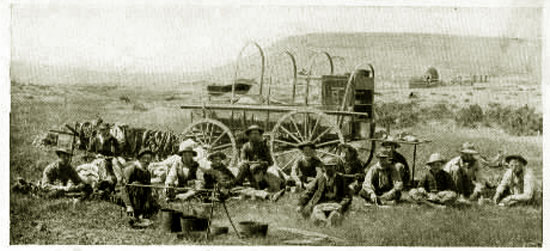
Dinner on Roundup, northern Wyoming, 1902.
Other fun was found with rattlesnakes. John Bratt recounted a little fun Tom Ritchie of the Ritchie Brothers outfit had on
Col. E. E. Webster of Webster & Randall's "H" spread. Wester came into the roundup camp along the North Platte. The roundup had
been soaked by a major thunderstorm. It was all they could do to stop the cattle from drifting. The camp, itself, was awash with water a foot or more deep:
Colonel Webster came into out camp. He was all in and resembled a drowned mouse. He threw himself down on a pile of sacked corn that we had in the
tent and fell asleep. The Colonel had a great dislike for snakes. Tom Ritchie had killed a big rattlesnake at the foothills and put it in the
pocket of his slicker. Noticing the Colonel sleeping he slipped the rattler into his
tobacco pocket. In a few minutes a cowboy entered the tent and inquired if any one had any tobacco. Someone said the Colonel had, when the
inquirer went up to him, awoke him and asked if he had any tobacco. The Colonel growled at being disturbed and began feeling in his
pockets, finally putting his hand on the snake. He jerked it out of his pocket, gave a high leap, nearly breaking his head on the
ridge-pole of the tent, his face changing from red to purple, then to white, as he leaped off the corn sacks into nearly a foot of
fast running storm water, swearing a blue streak that he would whip the man (calling out a very ugly name) who had put that snake into his tobacco pocket. Ritchie was
bent on licking the Colonel on account of the name he had called him but we managed to keep the
two apart. Trails of Yesterday. p. 244.
A tenderfoot might easily become the unwitting butt of the jokes. One such tenderfoot
from New York participated in a roundup near Madora, Dakota Territory. The tenderfoot had some peculiar habits: he wore
glasses, had a toothbrush, regularly shaved, didn't drink, and never cursed. The boys gave him an unbroken bronc.
At first the horse was gentle until he reached
the edge of a chasm. There, the horse turned into a "sunfisher;" that is, a horse
that jumps in end-to-end turns, always in the same direction so that the rider will become dizzy. The tenderfoot held
hung on for dear life. But by that afternoon, the tenderfoot was using the horse to
tend the cattle. Later the boys sent the tenderfoot off on a wild goose chase for some
alleged antelope about five miles back. The joke was on the boys. He came back with two antelope.
Thus, the tenderfoot was accepted. Later, the tenderfoot
wrote:
There was a good deal of rough horse-play, and,
as with any other gathering of men or boys of high animal
spirits, the horse-play sometimes became very rough
indeed; and as the men usually carried revolvers, and as
there were occasionally one or two noted gun-fighters among
them, there was now and then a shooting affray. A man
who was a coward or who shirked his work had a bad time,
of course ; a man could not afford to let himself be bullied or
treated as a butt; and, on the other hand, if he was "looking
for a fight," he was certain to find it.Theodore Roosevelt,
Autobiography, 1913.
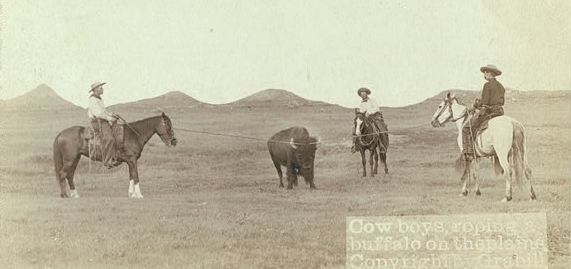
Roping a Buffalo, 1890, photo by J. Grabill.
Theodore Roosevelt in his 1893 Hunting the Grizzly and Other Sketches noted:
Cowboys delight in nothing so much as the chance to show their skill
as riders and ropers; and they always try to ride down and rope any
wild animal they come across in favorable ground and close enough up.
If a party of them meets a bear in the open they have great fun; and
the struggle between the shouting, galloping, rough-riders and their
shaggy quarry is full of wild excitement and not unaccompanied by
danger. The bear often throws the noose from his head so rapidly that
it is a difficult matter to catch him; and his frequent charges
scatter his tormentors in every direction while the horses become wild
with fright over the roaring, bristling beast--for horses seem to
dread a bear more than any other animal. If the bear cannot reach
cover, however, his fate is sealed. Sooner or later, the noose
tightens over one leg, or perchance over the neck and fore-paw, and as
the rope straightens with a "plunk," the horse braces itself
desperately and the bear tumbles over. Whether he regains his feet or
not the cowboy keeps the rope taut; soon another noose tightens over a
leg, and the bear is speedily rendered helpless.
I have known of these feats being performed several times in northern
Wyoming, although never in the immediate neighborhood of my ranch. Mr.
Archibald Roger's cowhands have in this manner caught several bears,
on or near his ranch on the Gray Bull, which flows into the Bighorn;
and those of Mr. G. B. Grinnell have also occasionally done so. Any
set of moderately good ropers and riders, who are accustomed to back
one another up and act together, can accomplish the feat if they have
smooth ground and plenty of room. It is, however, indeed a feat of
skill and daring for a single man; and yet I have known of more than
one instance in which it has been accomplished by some reckless knight
of the rope and the saddle. One such occurred in 1887 on the Flathead
Reservation, the hero being a half-breed; and another in 1890 at the
mouth of the Bighorn, where a cowboy roped, bound, and killed a large
bear single-handed.
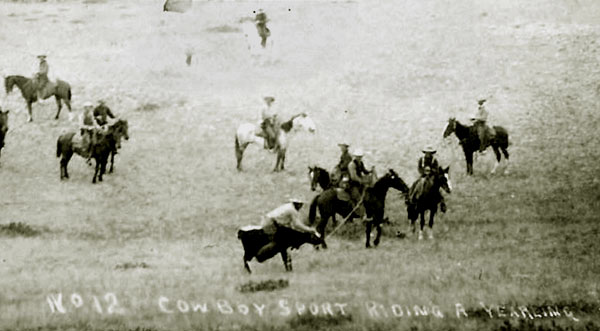
"Cowboy Sport, Riding a Yearling. Photo by J. D. Kirland.
Emerson Hough in his "Story of the Cowboy," 1908 observed:
There probably never was a round-up where the boys did not rope a steer for some ambitious c
owpuncher to ride bareback for a wager. This feat is not so easy as it looks, for the hide
of a steer, or, worse yet, the hide of a big fat bull, is loose and rolling, so that,
as the cowpuncher would say, it "turns plum over between a feller's legs."
Sometimes a yearling or a runty little "dogy" is roped for this form of sport, the
cowpuncher wreathing his long legs under its belly to its intense disgust and fright,
though he probably sits it safely when the ropes are "turned loose" in spite of its antics,
for it is the boast of a first-class cowpuncher that he can "ride ary thing that wears ha'r."
In some instances the riding of a yearling was not as a result of a bet, but a different form of entertainment
where a cowpuncher was picked out to be the brunt of a joke in the form of a kangaree court in which
he was accused of all kinds of offenses and naturally found guilty and sentenced to ride the
yearling.
Such antics as depicted above and below were frowned upon by some companies.
The XIT in its rules of conduct for employees provided: "Employees are not
allowed to run mustang, antelope or any kind of game on the Company's horses."
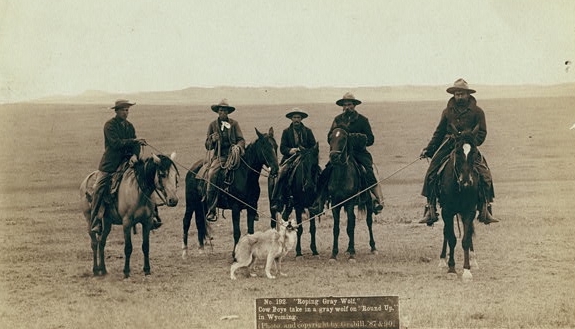
Roping a gray wolf, 1887, photo by J. Grabill
Of course there may have been a motive for roping wolves and coyote other than fun.
A small ranch might have one or two full-tme hands, otherwise the small ranchers relied on seasonal
crews that were paid by the day, typically $1.25 a day.
A full-time hand might receive $30.00 a month, but that pay would be greater than
those paid by the day. The waddie, paid by the day, was not paid for days he couldn’t work due to rain or snow.
To supplement income, bounties might be collected for killing coyotes, bobcats and
wolves. Wyoming paid $1.50 for coyote, $5.00 for a wolf, and $1.00 for a bobcat. Colorado paid $20.00 for a wolf.
After the pelt was displayed to the Clerk of the Court, ears and paws cut off and given to the clerk,
and the necessary affidavit filed, the hunter was then free to sell the pelt and receive
additional income. At the time, the coyote hide might bring from $1.00 to $2.00 in Chicago. Thus, as
discussed with regard to Wolfers, there were individuals who were employed full-time by ranchers or the
federal government to eliminate predatory animals.
As previously noted, the Cheyenne River Roundup of 1884 was the largest the State had ever seen. Unknown at the time that
General Roundups, or as they were sometimes called "Pool Roundups" would soon be a thing of the
past. The winter of 1886-87 was devasting. Settlers homesteading had fenced off portions of the range. Within three years general roundups
in many parts of the West were a thing of the past. The Spring Roundup of 1887 along the Cheyenne was participated in by only
four wagons. The 76 was in receivership and its last great herd was down to 10,000 head. The last general roundup in Alberta was in 1885 and the last in the Dominion in 1907. Nebraska saw its
last general roundup in 1887. In Montana by 1899 the great N Bar N was absorbed by Conrad Kohrs
and John Bielberg. Soon, it too would be only a memory. In South Dakota, the last "big roundup" was in 1902. That year, the general manager of the Sheidley Cattle Company, the Flying E,
negotiated a lease with the Federal Government of 865,429.5 acres Indian Reservation land. It was agreed that
the land was to be fenced thus effectively denying other cattlemen including the Indians of the use of the land. The leased land was to be used only
by the Flying E and by Lake, Tomb & Co. in which the general manager of the Flying E also had an interest. It was the largest singled fenced pasture in the world. The XIT in Texas
had more pasturage under fence but it was divisded up.
The leasing of the land required that all cattle on the reservation and in the Western Dakotas be rounded up, a "general cleanup" lest the unscrupulous
would claim that the cattle belonged to them. Some thirteen wagons were at the final checkin. Some 50,000 head were collected. Reservation wagons also participated.
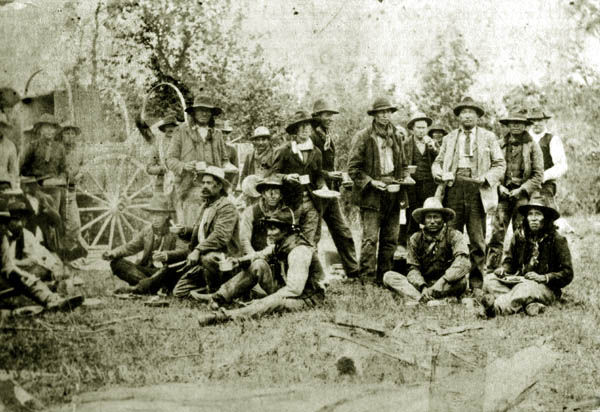
Native American Wagon and Cowboys, approx. 1902.
Reservations wagons had been participating in General Roundups since at least the "West River" roundup of 1887. The West River was the western half of South
Dakota. The West River Roundup covered an area of 400 by 200 miles including the east half of Montana,
Northwest Wyoming and the west half of Dakota. Some 24 wagons participated including two reservation wagons and two pool throwback wagons. Over the years, various brands have been used by
the Reservations including the Circle D G, the Circle D C, the ID, and the TID. The Bureau of Indian Affairs used the BIA, jokingly referred to as standing for
"Bosses Indians Around." Several Native American cowboys were highly regared including
Sam Yellow Knife who worked as a rep for the H E. Cattle Co., George Defender who worked for the L7 and the ZT and won first place at Miles City in 1914 and participated at Madison
Square Garden and Calgary, and David Blue Thunder who won first place in a Relay race at Frontier Days.
For extensive discussion of the 1902 West River Roundup, see Hall, Bert L: "Roundup Years, Old Muddy to Black Hills, Self Published, 1954. For discussion of the lease of Indian Lands in 1902 and the
Seidley Cattle Company, see Sanderson, Nathan B: "Dean of the Range: George Edward Lemmon, Open Range Cattle Ranching and the Development of
the Northern Great Plains;" a Dissertation presented to the Faculty of the Graduate
College of the University of Nebraska, Lincoln, in Partial Fullfilment of Requirements for the
Degree of Doctor of Philopsophy, Jne, 2011.
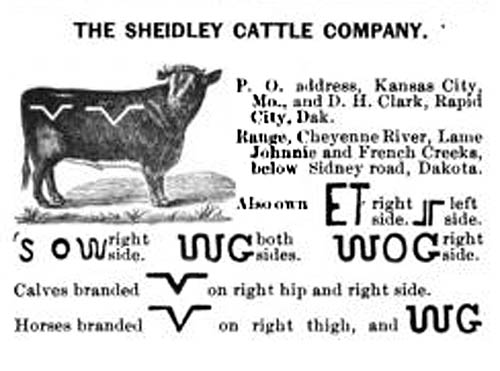
Sheidley Cattle Company Brands, 1884.
In Colorado one general roundup was held in the fall of 1917, but it was only to move cattle to
a winter range. Things held on a little longer in North Dakota. One last generalroundup was conducted in 1933. In 1912, n Wyoming, a general roundup was conducted in Laramie County along Bear Creek, Horse Creek and Pole Creek east to the
Nebraska bprder with C. B. Irwin as Roundup Boss. It was not to separate and brand calves. Instead, it was to see that all cattle in the
District were dipped because of an outbreak of scabies. In Converse County, one last general roundup was conduced in December 1919. A early blizzard had hit and it was for the purpose
of saving cattle which might otherwise starve or freeze.
This is not to say, that all roundups were a thing of the past. Small roundups were conducted by single ranches limited to their own brands. But the giant general roundups were gone.
In the far North Atlantic the practice of a general fall roundup continues--in Iceland, of sheep, called a “réttir.” During the winter,
sheep rather than left in the open are housed in large sheep sheds over the winter. In the spring after shearing, the sheep are left out on open range.
Music this page:
Roundup Time In Heaven
As sung by Jimmie Davis
Oh they tell me of a place and they tell me of a day
Where the saints shall be gathered to stay
They shall come from the east they shall come from the west
When we gather on that roundup day
When it's roundup time in heaven
And our troubles on earth are o’er
All the friends that death has severed
Shall gather on that golden shore
T’will be sweet when we meet at Jesus feet
With no heartaches no pains no sigh
When they comb heaven's plains will they call your name
At the great roundup in the sky
Dear love ones have I and perhaps have you
Who have recently gone on that way
But the time now is short for them and for me
Till we gather on that roundup day
When it's roundup time in heaven
And our troubles on earth are o’er
All the friends that death has severed
Shall gather on that golden shore
Twill be sweet when we meet at Jesus feet
With no heartaches no pains no sigh
When they comb heaven's plains will they call your name
At the great roundup in the sky
Jimmie Davis was a two-terms governor of the State of Louisiana as well as playing a cowboy in
"B" movies and composer and singer. His most famous song was "You are my Sunshine." He grew up as one of eleven children
in a two-room shack. He never knew his actual birthdate. With all of the children, allegedly his parents could not remember it.
Former Louisian Gov. Edwin W. Edwards told one audience at a tribute:
'Just imagine: He served two terms as governor of Louisiana and was never indicted. That's a genuine achievement.'
Next Page, Loneliness on the Range. |